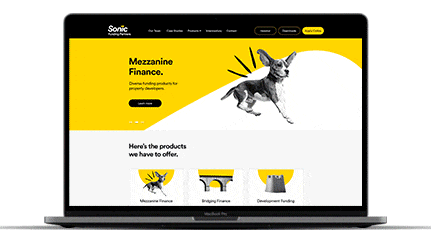Advanced Website Design with Focus on Functionality
Advanced Website Design with Focus on Functionality
Blog Article
Top Tips for Producing an Impactful Site Design That Transforms
To accomplish this, one have to think about a selection of variables, consisting of understanding the target audience, prioritizing customer experience, and maximizing for mobile systems. The calculated use of compelling call-to-actions and a well-defined aesthetic pecking order plays an important role in directing individuals with their journey.

Understand Your Target Target Market
Recognizing your target market is essential to effective internet site design, as it lays the foundation for developing an appealing customer experience. Determining that your customers are, including their demographics, choices, and actions, enables designers to customize the internet site's material, layout, and capability to meet particular demands.
Carrying out complete marketing research is crucial in this procedure. Studies, meetings, and analytics can offer useful insights right into individual assumptions and discomfort factors. By compiling this information, designers can develop user characters that stand for various sections of the target market, making sure that style decisions are educated and relevant.
Additionally, recognizing the target market helps in selecting proper design elements such as color pattern, typography, and images that reverberate with customers. A web site that talks directly to its target market fosters a feeling of link and depend on, encouraging longer visits and greater conversion rates.
Inevitably, a user-centered method to internet site design not only improves customer contentment but additionally sustains service goals by driving engagement and commitment. By prioritizing the demands and choices of the target audience, an internet site can successfully offer its objective and attain wanted results.
Prioritize User Experience
To boost the general efficiency of a web site, prioritizing individual experience (UX) is vital (Website Design). A properly designed UX guarantees that visitors can browse the website effortlessly, discover details quickly, and engage with material meaningfully. This brings about boosted individual fulfillment and greater conversion prices
Begin by applying instinctive navigating. Menus needs to be realistically structured, permitting customers to situate crucial areas of the site with marginal initiative. Uniformity in layout elements, such as shade plans and font styles, cultivates familiarity, which is critical for preserving user engagement.
Furthermore, consider the loading speed of your web site. A hold-up of just a couple of secs can lead to considerable drop-offs, as customers are less most likely to wait for a slow-loading page. Streamlining images and enhancing code can enhance performance and keep site visitors.
In addition, clearness in content discussion is crucial. Use succinct, appealing language and break up text with visuals to enhance readability. By focusing on individual experience, you not only develop a much more delightful environment for site visitors however also strengthen your brand's credibility. Inevitably, a concentrate on UX is a financial investment in the lasting success of your website.
Optimize for Mobile Devices
Optimizing for smart phones is critical in today's electronic landscape, where an increasing number of users access sites via mobile phones and tablet computers. A mobile-friendly style not just boosts individual experience yet additionally plays a considerable role in boosting internet search engine positions. To attain this, it is necessary to embrace a responsive design that instantly gets used to various screen sizes and positionings.

Packing speed is an additional essential element; mobile customers are commonly less client and anticipate rapid access to information. Maximize pictures and utilize internet browser caching to boost performance. Lastly, test your website try this out on multiple tools and screen resolutions to identify and remedy any possible use issues. By focusing on mobile optimization, you make certain that your website stays competitive and efficiently engages a more comprehensive audience.
Usage Engaging Call-to-Actions
A website's efficiency frequently rests on its capability to assist visitors towards preferred activities, making compelling call-to-actions (CTAs) vital components of layout. CTAs offer as the critical factors that guide customers to engage with the website, whether that implies buying, signing up for a newsletter, or downloading a source.
To develop efficient CTAs, quality is extremely important. Use succinct language that clearly interacts the activity you desire the individual to take. Phrases such as "Get going," "Register Free," or "Store Now" not only communicate necessity yet likewise remove uncertainty. The positioning of CTAs is just as important; they need to be strategically positioned throughout the website to guarantee they are easily noticeable, specifically in high-traffic locations.
In addition, the layout of CTAs must attract attention without being meddlesome. Employ contrasting shades and clear font styles to guarantee image source they catch interest. Additionally, think about utilizing directional hints, such as arrowheads or photos, to lead individuals toward these buttons. By concentrating on these aspects, services can substantially boost customer involvement, driving conversions and inevitably accomplishing their internet site's objectives.
Focus on Visual Power Structure
Efficient internet site style depends greatly on a well-structured visual power structure that overviews users with web content seamlessly. By arranging elements in a way that prioritizes information, developers can boost individual experience and help with decision-making. This entails using size, shade, comparison, and spacing purposefully to accentuate one of the most important elements of a web page.
Making use of bigger typefaces for headings and subheadings establishes a clear distinction between different sections, enabling individuals to check content easily. Furthermore, using contrasting shades for switches and calls-to-action can catch user attention and motivate interaction. Whitespace is another necessary element; it protects against mess and makes it possible for customers to concentrate on vital messages without interruptions.
Pictures and graphics should complement the message while likewise adhering to the well-known hierarchy, reinforcing the general message (Website Design). Uniformity in style elements, such as color systems and typography, more strengthens the visual power structure, making navigating user-friendly

Conclusion
In final thought, effective website layout necessitates a detailed understanding of the target audience, prioritization of individual experience, and mobile optimization. Ultimately, a well-executed site style offers as a critical part in driving user actions and attaining organization objectives.
Report this page